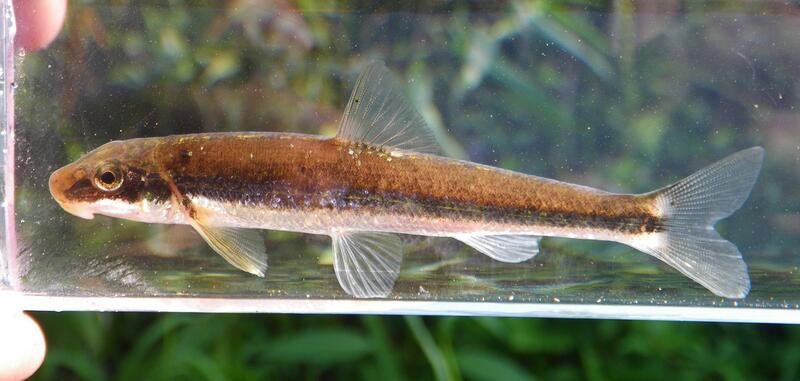







Loading profile. Please wait . . .
Phenacobius crassilabrum Minckley and Craddock, 1962
Fatlips Minnow





Federal Protection: No US federal protection
State Protection: Endangered
Global Rank: G3G4
State Rank: S2
Element Locations Tracked in Biotics: Yes
SWAP 2015 Species of Greatest Conservation Need (SGCN): Yes
SWAP 2025 Species of Greatest Conservation Need (SGCN): Yes
2025 SGCN Priority Tier: High Conservation Concern
Element Occurrences (EOs) in Georgia: 7
Habitat Summary for element in Georgia: Riffle areas in small to medium rivers
The fatlips minnow is slender and elongated with a sucker-like mouth and small scales. Hard pads (i.e., jaw plates) occur right behind the lips and bear strong ridges or tooth-like projections. There are 7 anal fin rays, more than 52 lateral-line scales, and 17-21 scales around the caudal peduncle. The body is olive to brown dorsally with an iridescent gold mid-dorsal stripe and a wide lateral band that may be darkly pigmented or yellow to gold in appearance. Breeding males develop rusty tints in the middorsal and lateral stripes as well as in the fins and on the sides of the head. The body below the lateral stripe is white as are the pelvic and anal fins. The pectoral, dorsal, and caudal fins are pale olive and there are pale areas above and below the caudal spot. The maximum reported total length for the fatlips minnow is 112 mm (4.4 in).
The combination of thick fleshy lips and hard jaw pads make it difficult to confuse the fatlips minnow with any other fish species in its range.
The fatlips minnow occupies riffles and runs in medium-sized streams and small rivers with clean gravel, cobble and boulders. It is often found in streams that are cold enough to support populations of trout.
The fatlips minnow has been reported to feed on larval midges, craneflies, caddisflies, and beetles.
Very few individuals live past three years of age. Spawning occurs from April to June based upon collection of animals in spawning condition during these months in Virginia and Tennessee. The only description of spawning behavior was an observation of males defending territories on the stone nests of river chubs (Nocomis micropogon). Spawning occurred at 15-17 °C (59-63 °F) and involved 1-2 males and a female. No additional spawning observations are known for the fatlips minnow or any of the other suckermouth minnow species.
Backpack electrofishing upstream of a stationary net can be effective, particularly in swift, rocky runs.
The fatlips minnow has a restricted range and is endemic to the upper Tennessee River drainage in Georgia, Tennessee, North Carolina, and Virginia. It is primarily found in the Blue Ridge physiographic province. In Georgia, the fatlips minnow has only been collected from a few sites in the Little Tennessee River system, including sites in Betty Creek and the mainstem Little Tennessee River. Check the [Fishes of Georgia Webpage](http://fishesofgeorgia.uga.edu/index.php?page=speciespages/species_page&key=phencras) for a watershed-level distribution map.
Threats to the existence of the fatlips minnow in Georgia include road-building, increasing urbanization, and failure to implement Best Management Practices (BMPs) for forestry and agriculture. The preference of fatlips minnows for clean coolwater streams with gravel bottoms suggests that they may not fare well in urbanized settings. Much of the riparian buffer along streams has been impacted or eliminated in the more developed region of Rabun County. This allows for an increase in sunlight, which can change water temperatures and allow sediment and excess nutrients to reach the stream more quickly. Hydrologic alteration as a result of increased pavement and other impervious surfaces is also a threat.
| Threat 1 | Threat 2 | Threat 3 | |
|---|---|---|---|
| General Threat | Pollution | Pollution | Climate change & severe weather |
| Specific Threat | Agricultural & forestry effluents | Domestic & urban waste water | None |
The fatlips minnow has been recently (in 2009) collected from Betty Creek and the mainstem Little Tennessee River. Collections are typically represented by one or just a few individuals.
Conservation of the fatlips minnow and other stream fishes in the Little Tennessee River system depends on maintaining and improving habitat quality. It is essential to eliminate sediment runoff from land-disturbing activities (such as roadway and housing construction), maintain and restore [forested buffers](https://www.tva.gov/Environment/Environmental-Stewardship/Land-Management/Shoreline-Stabilization) along stream banks, eliminate inputs of contaminants (such as fertilizers and pesticides), utilize the best technology available for treating industrial effluent and sewage, and maintain natural patterns of stream flow. There are many [technical assistance and cost-sharing programs](http://www.georgiawildlife.com/documentdetail.aspx?docid=370&pageid=1&category=conservation) that can help farmers implement best management practices to reduce sediment and nutrient pollution.
Etnier, D. A. and W. C. Starnes. 1993. The fishes of Tennessee. Univ. Tennessee Press. 681pp.
Jenkins, R. E. and N. M. Burkhead. 1993. Freshwater fishes of Virginia. American Fisheries Society. 1079pp.
Lee, S. L., C. R. Gilbert, C. H. Hocutt, R. E. Jenkins, D. E. McAllister, and J. R.Stauffer. 1980. Atlas of North American fishes. North Carolina State Mus. Nat. Hist. 867pp.
Minckley, W. L. And J. E. Craddock. 1962. A new species of Phenacobius (Cyprinidae) from the upper Tennessee River System. Copeia 1962: 369-376.
Page, L. M. and B. M. Burr. 1991. A field guide to freshwater fishes of North America north of Mexico. Houghton Mifflin, Boston. 432pp.
Byron J. Freeman
B. Freeman, 1999: original account
K. Owers, Jan, 2009: Updated status and ranks, added fish atlas link, converted to new format, minor edits to text
B. Albanese, Aug, 2009: added picture, general update of account, incorporated edits from Bill McLarney.
Z. Abouhamdan, April 2016: updated links